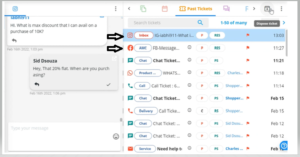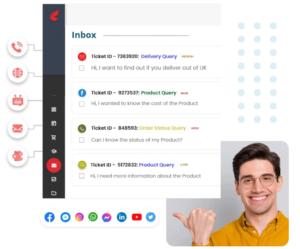In the face of changing customer expectations, businesses are witnessing an urgent need to deliver a personalized customer experience so as not to lose out in the marketplace.
Take a look at some of the key personalization statistics:
- 80% of consumers are more likely to buy from a company that provides a tailored experience
- 66% of consumers expect brands to understand their individual needs
- 70% of consumers say that how well a company understands their individual needs impacts their loyalty
- 71% of customers are frustrated by impersonal shopping experiences
- 72% of customers will only engage with personalized messaging – Source
The groundwork for delivering an out-and-out personalized experience involves making sense of the complex customer journey by understanding the customer’s perspective at all touchpoints in sync with their needs.
All of this comes down to having a 360-degree or end-to-end view of customer data, that enables you to become customer-centric and aids in the decoding of the customer’s psyche.
What is 360 Degree Customer View?
360-degree customer view refers to the critical information about the customer gathered by the company to offer personalized service.
This entails data from every interaction such as a phone conversation, website inquiry, product purchased, canceled order as well as the likelihood of business opportunities with the customer in the future.
The customer 360-degree view is becoming increasingly pivotal for any organization, in that it provides an integrated view of customer data from all tools, technologies, and applications employed.

Why do you Need a Customer 360 View?
You need a 360-degree view of the customer for the array of benefits it offers, be it for running personalized marketing campaigns and services or improving operational efficiency. On the whole, these benefits can impact the entire organization and be deeply felt by your customers, creating a brand experience that’s centered around the customer.
How a 360 Degree in Customer View Benefits your Business?
The 360-degree customer view gives the business an edge over its competitors by helping anticipate customer needs and providing contexts for deeper and meaningful interactions with customers.
This is merely an overview; continue reading below for more insights on how a 360-degree customer view can add value to your business.
Strengthens Customer Intelligence
Customer intelligence is the process of collecting and analyzing customer profile data to be used in gaining a deeper understanding and building meaningful relationships with customers.
Since the 360-degree customer data is comprehensive and consistent, you can build deeper customer relationships by understanding the best ways to interact with every customer. Such as, using contextual and location-based targeting, activity-driven product recommendations, personalized customer onboarding strategies, and sending persona-based communications.
Thus, a 360-degree customer view enables you to have a strong footing for infallible customer intelligence.
Predictive Analytics
Predictive analytics allows you to determine the future behavior of customers based on the present and historical data. Therefore, combining bits of information gathered from various sources gives a 360-degree view of customer data enabling you to have a clearer picture of the customer behavior. Analytics can tell you if there is a chance of customer churn, the probability of making a purchase, the reason for order cancellation, and so on. Not just this, you can analyze customer behavior patterns based on data, such as, what customers buy, where they spend time, how they shop, and so on.
Personalization
A unified customer data view tells you how to attune your interaction, campaigns, and services to match the customer’s requirements.
Here is an illustration to further drive home the idea. If a customer purchases baking essentials every month, you can send a reminder to make the purchase the following month via his/her preferred communication channel.
Or, if a new mother buys baby clothes, sending her a promotional email about baby toys can make her life easier and might even result in a sale. Thus, making the customer feel valued through personalized interactions paves the way for long-term customer loyalty.
“According to a study, 91% of consumers are more likely to shop with brands that offer relevant recommendations catered to them.”
Omnichannel Experience
Knowing customers’ buying patterns, channel preferences, interaction history, and every other insightful customer data is made possible by leveraging a single 360-degree customer view.
A customer, for example, messages you on your Facebook page and then calls you to complain about the same matter. The customer 360 degree shows you the time, date, and message posted by the customer. Further, it tells you if the customer is a frequent one, his past orders, and transactions, and a long list of other critical information. When you answer their call, you have now a bunch of information to be able to offer an impressive experience in their best interest.
A 360-degree view of customer data truly empowers you to offer a frictionless omnichannel customer experience across all channels.

Omnichannel help desk inbox
Improved Customer Experience
A 360-degree view of customer data lets you understand the customer on a deeper level and thereby, helps you successfully improve the customer journey. When a customer contacts you, having complete knowledge of the customer, such as knowing the customer is a loyal/troublesome one, enables you to appropriately address their query.
A complete information profile of the customer lists the most recent service requests logged by the customer, who assisted, the recent purchases or orders, and so on.
When you are well-informed about the customer’s interactions with your company, your representatives do not need customers to explain themselves. Also, the representatives are not required to ask, “Where are you located”?, or “Has this problem ever occurred to you?”.
The 360-degree customer view provides all the context relevant to understanding and interpreting a customer’s problems and enables you to deliver an accurate and faster response.
“A survey carried out by Forrester Research in 2018, found that 42% of surveyed service agents, said they were unable to efficiently resolve customer issues due to lack of easily accessible and complete customer information.”
Cross-Departmental Collaboration
As the 360-degree customer view bridges data siloes, it enables your teams to collaborate and make decisions better. The different departments across the organization can now make aligned decisions by relying on a united data view. This transparent visibility of data enables the departments to work smoothly without having to debate conflicting insights provided by siloed data.
Aligning different teams is a strategy for organizational success, and getting the alignment straight requires you to have extensive customer data to fill in the gaps. Accessing a unified data view can have every team and every department on the same page working towards a common goal sensibly.
Challenges of Implementing a Customer 360 View
We have just read about the benefits of having a 360-degree view of customer data. But let us now check the ground reality and understand what makes it so hard to centralize the data.
Data Siloes
It is a common scenario where multiple applications remain in use across different departments of the organization. The customer data, now spread across different systems make it strenuous to truly know the customers, accomplish personalized campaigns or service and even manage records.
Having a cloud-based CRM solution can help you keep all of that data in one place to give you a consolidated view of your customers.
Kapture’s CRM solution smoothly integrates with all data sources, third-party applications, social media, cloud telephony, email, and chats while also ensuring that every staff member has access to the data they need.
Poor Data Quality Control
It is a bitter fact that only a few organizations realize that the data they maintain is substandard when it comes to its quality. Bad data quality could be the result of ineffective data migration, improper maintenance of data quality, or poor data gathering process.
Data quality is what gives you an effective 360-degree view of customers. It is your building block upon which you are going to build your business forecast, product recommendations, positive customer experience, and every other aspect of strategic importance.
To improve the data quality,
- Follow the best data migration practices while implementing the CRM, schedule periodic data clean-ups, and optimize data collection procedures.
- Adopt fool-proof data collection and governance practices such as setting up standard data fields and formats, data validation, naming conventions, and so on.
- Robust CRM solutions, such as Kapture’s, can help you in data cleansing by helping you identify duplicate data and eliminating them by merging duplicate contacts.
- Moreover, you can locate missing or incomplete information by carrying out applying customized search filters. It just that you just need to get responsible for your data quality to ensure that you have accurate, complete, and superior data to arrive at key decisions.
Getting Buy-in from Key Stakeholders
Senior leaders or managers of various departments may not be open to the idea of consolidating the data. They have their own policies, procedures, and ways of collecting and analyzing data. Since these departments are used to working in their own worlds data siloes get built creating barriers around them. Therefore, it is important to embrace a cross-department support work culture via data consolidation throughout the organization to thrive in today’s fast-paced cloud-driven business environment. Not doing so, can limit communication and collaboration, exhaust your storage space, reduce productivity, diminish the usefulness of data, and lead to poor decision making thus slowing down your organization.
How to Build a 360 Customer View?
Auditing Customer Data
Accurate, complete, and up-to-date data is what makes the 360-degree customer view workable and functional to serve its intended purpose. Therefore, conduct regular audits of customer data as an initiative to sustain the fineness of data quality. Auditing helps you keep the data clean and organized.
Use of Social Media Channels
Social media is the most preferred channel of customer interaction. They prefer to raise service requests, complaints, reviews, and feedback through popular channels such as Facebook, Twitter, Instagram, or WhatsApp. So what if you handle your social media in isolation, a huge chunk of customer interaction details remains in separate inboxes.
Kapture’s CRM solution seamlessly integrates with all of these social media channels with no glitches and letting you have all these conversations directed to a single help desk inbox.
Thus, helping you enrich your customer profiles and giving you a holistic view of customers.

Customer Relationship Management Systems (CRM)
CRMs store customer data on a centralized cloud database letting you track data across all touch points in the customer journey.
It helps you build a 360-degree view of customers through its smart integrations with third-party tools and applications that serve as your data sources.
CRMs organize and segment customer profiles based on demographics and detailed customer persona helping you make better decisions and deliver personalized services.
It aligns different departments and helps achieve successful cross-functional collaboration.
Get Unwavering Customer 360 Degree View with Kapture
Kapture’s effective cloud-based CRM solution helps you maintain a 360-degree view of customers and improve the customer service experience. Our intuitive CRM helps you discover insights for identifying better business opportunities, enhancing customer experience, and positioning your business for success by having you in sync with your customer’s requirements.
Kapture’s seamless integration and omnichannel capability interconnect disparate data sources, and help you access and manage the torrent of data that is pouring in from everywhere.
Furthermore, our enterprise-grade security standards let us diligently serve as your trusted partner when you set out to build a full-blown and thorough customer data perspective.









